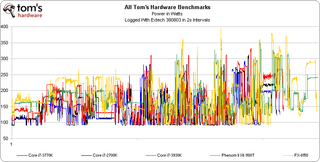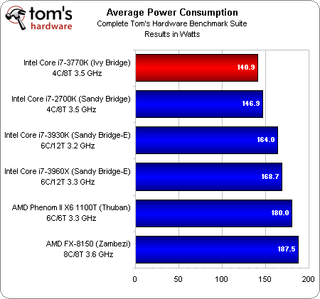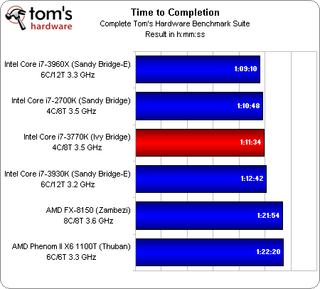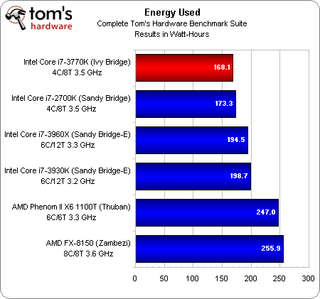Intel Core i7-3770K Review: A Small Step Up For Ivy Bridge
Power Consumption And Efficiency
We now know that, as a host processor, Core i7-3770K really isn’t that much faster than Core i7-2700K. But we also know that Ivy Bridge should be capable of delivering better (or at least similar) performance in a significantly lower thermal envelope. In this case, the -3770K is a 77 W part, whereas Core i7-2700K is a 95 W processor and the Sandy Bridge-E-based chips are rated for 130 W.
Rather than simply letting each chip sit on the Windows desktop and then spin them all up, reporting idle and load consumption figures, we instead created a script using all of the tests in our benchmark suite (aside from the games and the Google Chrome compilation) with short rests in between. The resulting metric is more than an hour long on even the fastest processor in our collection, and it’s truly a real-world mix of idle and load.

It’s frankly pretty difficult to make sense of the raw, logged data, even with our normal chart expanded out to make the hour-plus run more readable. Certain segments make it quite clear, however, that the Core i7-3770K is the lowest-power contender tested, followed by the Core i7-2700K, the Core i7-3930K, the Phenom II X6 1100T, and finally AMD’s FX-8150. What about the -3960X? We have the data for that one as well, but the additional line makes this chart even more of a mess, so I left it off. I also have data for the -2550K, but I’m working on a surprise with that information.

There we go. It’s much easier to average out power consumption during each run and compare the result. As hypothesized using the line graph, we see each CPU land exactly where we expected it to, with the -3960X falling in just behind the -3930K.

It’s pretty darned easy to measure how long each sequence runs, since our logger takes a sample once every two seconds. Not surprisingly, the Core i7-3960X finishes first. It’s more interesting that the Core i7-2700K is just slightly quicker through the benchmarks than Core i7-3770K. Both AMD trail quite a ways behind.

Multiplying average power by the time required to complete the benchmark gives us total energy used in watt-hours, reflecting efficiency.
The Core i7-3770K’s solid performance, coupled with a reduction in power consumption, results in the lowest power use in the course of our suite. The Core i7-2700K follows closely behind, though.
Stay on the Cutting Edge
Join the experts who read Tom's Hardware for the inside track on enthusiast PC tech news — and have for over 25 years. We'll send breaking news and in-depth reviews of CPUs, GPUs, AI, maker hardware and more straight to your inbox.
Both of the Sandy Bridge-E chips facilitate impressive performance numbers throughout our testing, excelling particularly in threaded workloads. However, 130 W TDPs penalize the LGA 2011-based CPUs when it comes to power consumption, so they fall into third and fourth place.
The Phenom II X6 and FX bring up the rear, as they both use more power and underperform the Intel competition. It’s an unfortunate state of affairs for AMD, but the Piledriver core is being prepped for operation in the company’s next APU design. Hopefully, changes made to Bulldozer ameliorate some of what we’ve come to dislike about today’s FX.
Current page: Power Consumption And Efficiency
Prev Page Benchmark Results: World Of Warcraft: Cataclysm Next Page How Much Faster Is Core i7-3770K Than -2700K And i5-2550K?-
tecmo34 Nice Review Chris...Reply
Looking forward to the further information coming out this week on Ivy Bridge, as I was initially planning on buying Ivy Bridge, but now I might turn to Sandy Bridge-E -
jaquith Great and long waited review - Thanks Chris!Reply
Temps as expected are high on the IB, but better than early ES which is very good.
Those with their SB or SB-E (K/X) should be feeling good about now ;) -
xtremexx saw this just pop up on google, posted 1 min ago, anyway im probably going to update i have a core i3 2100 so this is pretty good.Reply -
ojas it's heeearrree!!!!! lol i though intel wan't launching it, been scouring the web for an hour for some mention.Reply
Now, time to read the review. :D -
zanny It gets higher temps at lower frequencies? What the hell did Intel break?Reply
I really wish they would introduce a gaming platform between their stupidly overpriced x79esque server platform and the integrated graphics chips they are pushing mainstream. 50% more transistors should be 30% or so more performance or a much smaller chip, but gamers get nothing out of Ivy Bridge. -
JAYDEEJOHN It makes sense Intel is making this its quickest ramp ever, as they see ARM on the horizon in today's changing market.Reply
They're using their process to get to places they'll need to get to in the future -
verbalizer OK after reading most of the review and definitely studying the charts;Reply
I have a few things on my mind.
1.) AMD - C'mon and get it together, you need to do better...2.) imagine if Intel made an i7-2660K or something like the i5-2550K they have now.
3.) SB-E is not for gaming (too highly priced...) compared to i7 or i5 Sandy Bridge
4.) Ivy Bridge runs hot.......
5.) IB average 3.7% faster than i7 SB and only 16% over i5 SB = not worth it
6.) AMD - C'mon and get it together, you need to do better...
(moderator edit..) -
Pezcore27 Good review.Reply
To me it shows 2 main things. 1) that Ivy didn't improve on Sandy Bridge as much as Intel was hoping it would, and 2) just how far behind AMD actually is... -
tmk221 It's a shame that this chip is marginally faster than 2700k. I guess it's all AMD fault. there is simply no pressure on Intel. Otherwise they would already moved to 8, 6, and 4 cores processors. Especially now when they have 4 cores under 77W.Reply
Yea yea I know most apps won't use 8 cores, but that's only because there was no 8 cores processors in past, not the other way around
Most Popular



